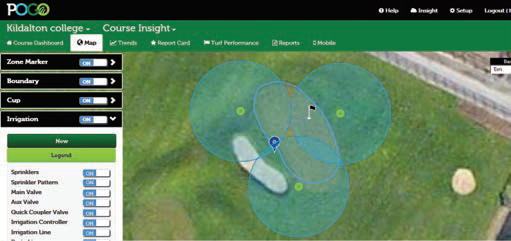Eamon Kealy, turfgrass specialist and lecturer in horticulture at Teagasc, Kildalton, taps into the latest technological advances and finds water and electronics can go well together
Times have changed. Technology is now making an impact on nearly every second of our daily lives. Sportsturf management is no different. Advances in technology are now allowing superintendents to make key ‘informed decisions’ based on data collected from sensors.
Soil moisture meters have been used for many years to collect data regarding the condition of the root zone. Most work on the principle of measuring an electrical signal between two or more probes that are inserted into the soil and converting this signal into a number; normally volumetric water content. There are many on the market. The most commonly used are the Delta Theta Probe and the Spectrum Field Scout TDR300. Each system is simple to set up and use.
The superintendent can also choose to install in-ground wireless moisture sensors. These systems are normally more expensive but can be used to measure moisture, salinity and temperature. Some systems have the capability to collect data from up to 500 sensors on the course.
Superintendents can now measure soil moisture, pH, EC, temperature, firmness, smoothness, trueness and speed of greens relatively easily and cheaper compared to 15 years ago. All this data is really only useful if you can break it down to analyse what is influencing your playing and growing conditions. In other words, these insights into turf performance are really worthless unless you can act on the data. For example, understanding that your greens start to show signs of drought at 8% volumetric water content will allow you to pre-empt yellowing grass and stay one step ahead.
Actionable insights give superintendents the information to make the right decisions more often, such as when to water, aerate or apply fertiliser or wetting agents. Until now these key decisions have been taken based on the superintendent’s’ education, experience or gut feeling. While this can be successful, taking the guesswork out of the equation can lead to more consistent playing surfaces and a reduction in unnecessary inputs over long periods of time. An informed decision will always be better than a guess.
At a recent Teagasc seminar entitled ‘Shaping the Future: Targeting Opportunities for ICT in Agriculture’ one of the take-home messages was how easy it is to collect data. You can place a sensor onto almost anything but designing systems that analyse this data and provide solutions for superintendents is where future opportunities lie. At the same seminar, Professor Willie Donnelly explained that the real value in sensor technology is connecting them to the internet. This allows for the data to be analysed in real time and acted upon immediately if necessary.
One such system that utilises cloud technology is the POGO Turf Pro. The system has GPS, WIFI and a measures canopy temperature, moisture and EC in the soil. Once a course is mapped it can be used daily by a superintendent to measure, capture and analyse course data. Superintendents can then use this information to make informed decisions.
The POGO geotags the position of each data sample taken on the golf course. It then uploads the data to its online portal and overlays the data on a base map for ease of analysis. Superintendents can set alerts for critical levels of EC or moisture, making it easier to make the right decision. All this material is then made available on your smartphone for quick decision making. It can also be used to map drainage or irrigation pipes ‘as built’ ensuring that should there be any future issues with a connection it can easily be relocated. This function would be of great interest to contractors working on multiple sites with multiple crews making it easy to track completed works.

Storing data in the cloud is expensive. The aim of good data collecting and analysing systems should be to minimise the amount of data stored but maximise the contextual data. In other words, the system should only store information that will allow the superintendent to make better decisions. Data for the sake of data normally equates to noise and should be avoided.
AUTOMATED DECISION MAKING – WEATHER STATION INTEGRATION
Weather is something that affects us all. Golf course superintendents are some of the best informed amateur weather forecasters. Planning routine maintenance on the golf course always revolves around the weather forecast. Hollow coring, topdressing and applying herbicides all rely on the correct weather conditions for optimum results.
Recently, technology giant IBM acquired The Weather Company in a reported 2 billion dollar deal. This will give IBM access to over 2.2 billion weather forecasting stations around the world. This opens up a whole new world regarding integration of analytics, data collection/sensors and weather forecasting.
For example, existing data collection systems such as the POGO Turf Pro could access information provided by IBM/The Weather Channel to give real-time data and recommendations to superintendents. In the future golf courses could even be provided with automated decision-making software which will remove all guesswork from decisions. This is still a long way off but the possibilities are endless.

THE FUTURE – WHERE WILL IT ALL END…?
It is hard to believe how far we have come in technology terms over the last 15 years. The smartphone is the ultimate example of this. Complete automated decision making on the golf course may be on the distant horizon but the pace the technology revolution is continuing at is frightening.
Future developments will be based around smaller, cheaper and more intelligent sensors. The incorporation of nanotechnology will revolutionise data collection. One day maybe sensors will be even be built into the sole of the boot of the greenkeeper, constantly monitoring the root zone below as they hand cut greens. More accurate GPS referencing to pinpoint problems to the millimeter may also be possible in the future.
Pesticides and fertilizers encapsulated in nanoparticles are being developed by manufacturers. These have the potential to be time released or released based on very specific environmental triggers. This technology may not become available in the short term but has massive potential to increase chemical efficacy while reducing wastage.
With all these technological uncertainties, one thing is for certain, the role of the greenkeeper will remain an important one. ✽
 EAMON KEALY M.Hort.Sc is a lecturer in Horticulture, specialising in Sportsturf Management at Teagasc, Kildalton and can be contacted at eamon.kealy@teagasc.ie EAMON KEALY M.Hort.Sc is a lecturer in Horticulture, specialising in Sportsturf Management at Teagasc, Kildalton and can be contacted at eamon.kealy@teagasc.ie |





